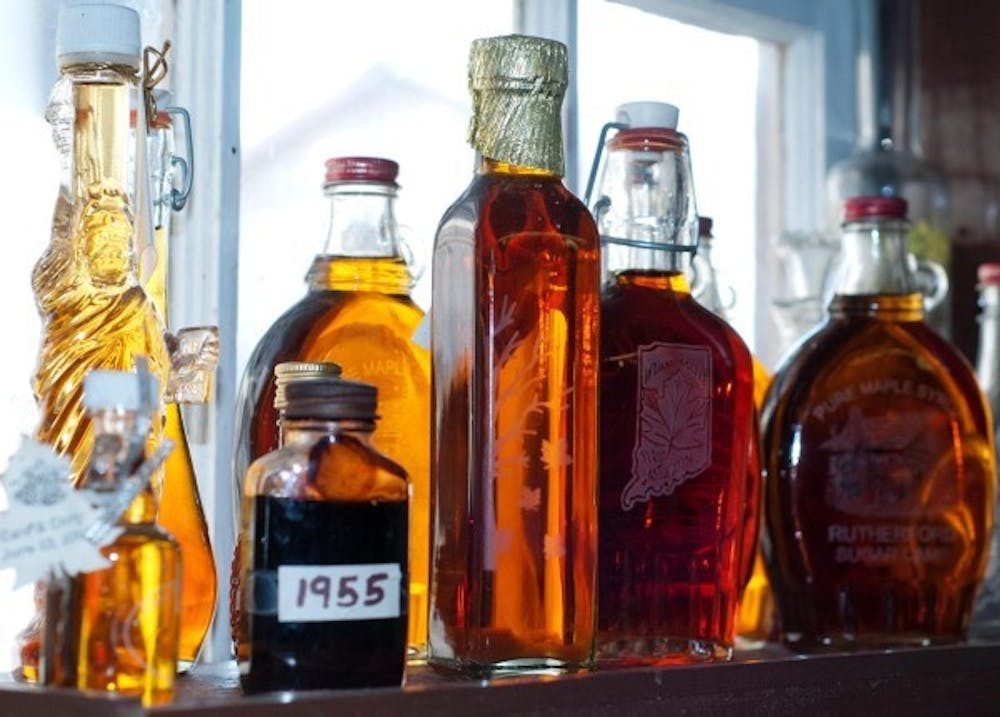The first thing you notice when you get out of the car at the Rutherford Sugar Camp is the smell.
Located about an hour southwest of Muncie in New Castle, it's a mix of cooking sugar and burning wood. It's a smell that's been coming from the cooking stoves for more than 100 years.
In 1911, Lewis Rutherford began producing maple syrup at his home, and it's been cooked there ever since. In 1977, owner Bill Rutherford, his son, passed away. A year later, Bill's son-in-law, David Hamilton, a former Muncie history teacher, bought the business. His years spent dating Rutherford's daughter, Carol, were spent learning the art of making syrup.
"I didn't know anything about maple until I started dating Carol," Hamilton said.
To talk to the workers of the sugar camp is to talk in a special lingo. Tree sap is called sugar water; a reverse osmosis machine is known as the RO; and the evaporator, a machine used to boil sap into syrup, is simply called the evaporator.
Since Hamilton bought the camp, there has been a period of modernization. The stereotypical sap buckets that hang from trees have been replaced by hoses that feed collecting tanks, powered either by gravity or by vacuum pump. A reverse osmosis machine has been added to the process, a machine that helps concentrate the sugar in the sap so that less is needed to produce syrup, cutting the production time by half.
Before the introduction of propane and the RO, cooking syrup could take up to 16 hours or more. The sugar water was boiled using wood, and it takes a lot of sugar water to make a little syrup. On average, about 43 gallons of sap creates one gallon of syrup. The RO machine reduces that to a relatively smaller 11 gallons of sap.
"My father would be so amazed at how it has changed," Carol said.
Even with the modern technology, the process still requires a lot of work and people to do it. Hamilton has several volunteers who help with the production of the syrup and the mechanical maintenance. Most of them have known Hamilton for years.
"Dave was my seventh grade history teacher," said Larry Hedrick, a man who is called the mechanics master. "In my high school years, I would come over here and work. That's how I got started. Now, it's strictly the enjoyment of it."
When you walk into the store a sign informs you that if there is no person there to take your money, that's fine. The store works on an honor based system. If someone takes any syrup they're trusted to pay for it, a fact that Hamilton takes pride in.
"I could tell you some stories about that," he said with a chuckle.
He then proceeds to talk about a customer who left a check on the counter for years without ever meeting Dave. In 100 years, there has only been one bad check given to the Sugar Camp, which was not from the previously mentioned customer.
The syrup made by Hamilton is pure. There is no added sugar or other ingredients. It leaves an aftertaste almost like weak honey and is sweet enough to give a slight boost to the system. He describes it as high-class syrup.
The inside of the old cabin, where syrup was once made and where it is sold today, is covered in old relics that have been given to the Hamiltons by friends and neighbors. The Sugar Camp sits alone on a road that, as Carol remembers, used to house several more syrup-making operations. In a way, it's one of the last of its kind in East Central Indiana. That's part of the reason Hamilton keeps the camp going.
"This is something unique. And it's a way to keep history alive and on a local scale," he said.





